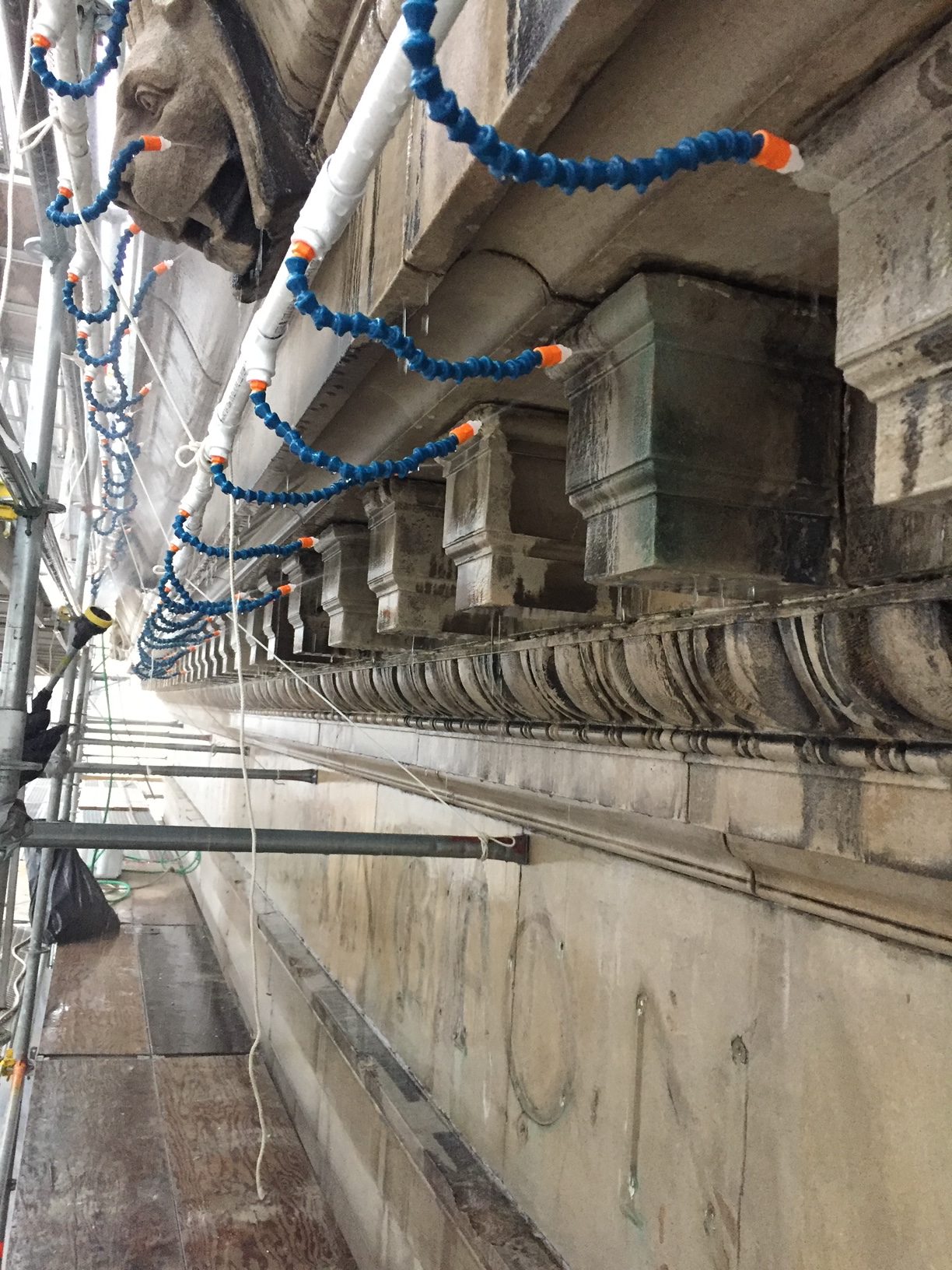Historic masonry, whether it is historic stone; historic brick or historic architectural terra cotta, can accumulate many different types of staining and atmospheric soiling. Overtime all masonry will become dirty, spotted by algae growth or otherwise discolored stemming from a multitude of causes. Cleaning new masonry and cleaning older historic masonry are generally done for different reasons and entail two very different methods for cleaning. With new masonry the reasoning behind the initial cleaning is relatively straight forward, new masonry is cleaned after the mortar has set in the new wall to remove construction debris and excess mortar from the masons laying the brickwork, it is typically cleaned with a much harsher chemical cleaning process than that used on historic masonry buildings. In historic masonry restoration the reasoning can entail more thought and concern for the integrity of the masonry. It is not always as simple as “This wall looks dirty, let’s clean it.”, though aesthetics is always a point of discussion. With this article I intend to briefly describe some of the different types of masonry staining as well as some considerations commonly undertaken in the early stages of historic masonry restoration as it is related to the cleaning of historic masonry.
Historic masonry cleaning is typically undertaken for one of two reasons if not a combination of the two. The first is for aesthetics and the second is for the integrity of the masonry itself. It may surprise some that aesthetics is not the sole consideration for cleaning historic masonry. In fact, many owners of historic buildings may not realize their building needs to be cleaned for the integrity of the masonry.
When looking at a building from an aesthetic perspective it can be relatively straight forward to ascertain whether the masonry would benefit from a good cleaning. Often it only takes a small amount of clean water with a scrub brush to see the difference when the soiling is removed. Looking at the masonry from the point of view of a professional historic masonry restoration specialist angle can open a more detailed array of issues such as biologic growth and mineral efflorescence (more on these later in the article) that can be detrimental to the longevity of the building itself. It is important to note that just because historic masonry could benefit aesthetically from cleaning does not necessarily mean that it should be cleaned. Depending on the condition of the historic masonry, the cleaning may cause more harm than good. If, for example, the historic mortar is overly deteriorated or has large cracks and voids that would either be intensified by the cleaning or allow moisture from the cleaning process to enter the structure the masonry may require repair and stabilization prior to cleaning.
The best historic masonry restoration contractors can be extremely valuable in the initial assessment process and most will do a cursory review without charge for the purpose of guiding the expectations prior to further investigation and planning of a historic project. If you are considering a historic masonry cleaning project, I highly recommend that you get an experienced historic masonry contractor on board as early in the process as possible.
As discussed earlier, there are many different types of staining and soiling that occur within historic masonry. I will list and discuss a few here with some cleaning methods.
- Atmospheric Soiling on Historic Stone, Brick and Architectural Terra Cotta
- These types of staining are the most common and often can be removed by the gentlest cleaning process which is simply low pressure (less than 400 psi) clean water left to dwell for a period then gently scrubbed with a soft bristle brush followed by a rinse down with clean water, again at low pressure. If after testing it is determined that more cleaning is desired, a mild detergent or non-acidic light duty restoration cleaner may be added. Often when cleaning brick and stone facades it is useful to add the use of hot water to the cleaning process.
- These types of stains occur when dust, dirt, and other particles in the atmosphere (air) around a building are deposited on the surface of the masonry. Often when the masonry becomes wet these particles will deposit on the wall and be absorbed by the moisture as it sits on the structure. Although most of these particles remain on the surface as the moisture evaporates, some will be pulled naturally into the subsurface of the masonry as the moisture is absorbed through tiny pores naturally occurring in stone and brick or unglazed terra cotta. As the dirt and dust particles are generally larger than the pores of the masonry these are typically easily washed away with a gentle cleaning.
- Pollution and Carbon Stains on Historic Stone, Brick and Architectural Terra Cotta
- Carbon based pollution stemming from vehicle exhaust and other causes is often pulled into the pores and deposited within the masonry giving a food source for certain bacteria to grow. When this is occurring, it is common to see black staining at the masonry, the black color comes from the bacteria growth and not the carbon. Softer and more porous stones such as limestone will often exhibit this type of staining particularly at the features that stick out from the wall such as at cornices, copings, and specialty window features.
- This type of staining is not only an eyesore but can be devastating to the masonry as the bacteria grows it will not only feed off the carbon but the masonry itself as well. Additionally, the bacteria colony can push against the pores and cause the masonry to fail if left untreated for too long. Cleaning these types of stains can often be accomplished by a gentle clean like that used for atmospheric stains, with the addition of a light duty restoration cleaner, aided by the application of a specialty biocide developed for this type of application. Prevention may include installing a zinc strip somewhere above where this staining occurs.
- Biologic Growth on Historic Stone, Brick and Architectural Terra Cotta
- Biologic growth such as algae and moss stems from these organisms feeding off moisture trapped within masonry and using the sun as its food source. Often occurring on lower portions of masonry walls and shaded sides of a building. Biologic growth on masonry can be removed by an application of a specialty biocide developed for this type of application. With the biocide left to dwell, biologic growth on masonry will usually be removed with a single application.
- Plant Growth on Historic Stone, Brick and Architectural Terra Cotta
- Plant growth is particularly detrimental to historic masonry structures and should always be removed immediately upon discovery. It is important that all the plant’s roots are removed which may require removal and resetting of the affected masonry by a trained historic mason. Often this occurs when plants, such as ivy, grow close to the base of a masonry structure and send runners up the wall which can grab hold of the small pores in the masonry or the surrounding mortar joints. These roots will eventually expand and cause small openings for moisture to infiltrate the structure which leads to many future issues and eventual failure of the wall.
- Efflorescence on Historic Stone, Brick and Architectural Terra Cotta
- Efflorescence is a natural occurrence in masonry structures. It refers to the naturally occurring minerals or salts within the masonry being pulled out to the surface through evaporation of moisture which contains the dissolved minerals. When the moisture reaches the surface of the masonry it will evaporate leaving the minerals behind. Efflorescence can come in many different colors, I have seen blue, green, orange and most often white. Sometimes leaving deposits of several inches thick.
- Efflorescence can be cleaned using a specialty historic restoration cleaner and elbow grease (scrubbing with wood paddles and brushes). Once cleaned efflorescence will often return if the underlying issue is not addressed. This underlying issue is the existence of moisture within the structure. Moisture may exist in masonry for several reasons and every occurrence of efflorescence should be investigated by a trained specialist. Some common reasons for moisture within masonry structures are, “rising damp” or moisture being wicked up from the ground, inadequate sealants at windows and openings or walls not being properly covered from above. Moisture issues within historic masonry can easily be a topic of its own article.
- Ferrous (Iron) and Metallic Staining on Historic Stone, Brick and Architectural Terra Cotta
- Metallic stains can occur from naturally occurring minerals within stones or from iron intentionally placed within the structure for reinforcing of attachment of items to the wall. Often historic structures will have architectural features created from copper that will bleed onto the masonry as they oxidize leaving green streaks behind as rain washes down the face of the building. Metallic staining can be stubborn to remove. Some staining may be removed by specialty cleaners that are highly acidic which can harm surrounding masonry, so it is important to test first in a small area and be sure to keep the cleaner as targeted as possible. Other methods of metallic stain removal include differing types of poultices consisting, basically, of an absorbent material such as tissue paper or clay with a cleaning solution that is left to dry on the masonry and is intended to pull the stain out of the pores.
- Paint and Graffiti on Historic Stone, Brick and Architectural Terra Cotta
- Paint can be removed from masonry using a specialized material that is applied to the area of painted masonry, left to dry and adhere to the paint then the material can be pulled away with the paint attached to the cleaner. Other chemical treatments are available and can be tested for effectiveness. Historic paints will sometimes contain lead, which is a hazardous material, and will require trained specialists to handle. Highly abrasive methods such as sand blasting should never be used on historic masonry.
These are just a few of the different types of staining that can occur on historic masonry structures and there are several other options for cleaning brick, stone and architectural terra cotta that may give good results. One other method of cleaning historic stone and other masonry types includes a very gentle constant water wash or “misting” technique which aims to keep the masonry wet for a period up to several hours or more then rinsing and wiping the dirt away. Others include abrasive techniques using specialized aggregate such as glass beads, baking soda or sponge material. When dealing with any abrasive method it is very important to test first and fully understand what is happening to the surface of the structure before choosing this type of cleaning for historic buildings.
One final note to keep in mind when dealing with restoration cleaning on historic masonry buildings is to always use the gentlest means possible. This advice comes from the National Parks Service and is very important to keep in mind, once damage has been done it can be very difficult if not impossible to reverse so caution is required. Also know that there is a very dedicated and very specialized industry that devotes itself to this type of work. The cost of a professional will undoubtably pale in comparison to the cost of improper cleaning that results in damage to the building or its occupants.







